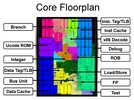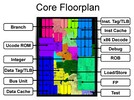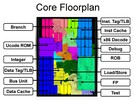AMD E1-2100 vs AMD E2-3000 vs AMD E1-2200
AMD E1-2100
► remove from comparison
The AMD E1-2100 is a mobile dual-core SoC for low-end subnotebooks and netbooks, which was presented in mid-2013. In addition to 2 CPU cores with a base clock speed of 1.0 GHz (no turbo), the 28-nanometer chip also integrates a Radeon HD 8210 GPU, a single-channel DDR3L-1333 memory controller as well as the Southbridge with various I/O- ports.
Architecture
Both Kabini (for notebooks) and Temash (tablets and compact subnotebooks) are based on AMD's new Jaguar architecture, which replaces the previous Bobcat models (e.g. the E-350). According to AMD, the performance per clock has been increased by about 15 percent. Furthermore, various modern instruction set extensions such as SSE up to version 4.2, AVX and AES are now supported. The finer 28-nanometer process from TSMC allows lower voltages and/or higher clock rates compared to Bobcat, as well as up to 4 CPU cores (Bobcat: 2 cores).
Performance
The average E1-2100 in our database is a really, really slow CPU, trailing behind the Celeron N2805 among other low-end chips. The E1's low clock speed of just 1 GHz means that something as simple as opening Windows Explorer will take quite a few seconds, not to mention more demanding activities.
Graphics
The SoC integrates a Radeon HD 8210 GPU with 128 shaders, which is based on the GCN architecture. The core is clocked at 300 MHz (no turbo). On average, the HD 8210 matches the Intel HD Graphics (Ivy Bridge). However, the performance is often limited by the CPU. Recent Games (as of 2013) are therefore hardly playable. Only a few older and less demanding games will run fluently.
Power consumption
This AMD APU has a 9 W TDP which is low and thus good enough for ultra-compact laptops, tablets and mini-PCs with no active cooling solution.
The E1-2100 is built with a 28 nm process making for really, really poor energy efficiency, as of 2022.
AMD E2-3000
► remove from comparison
The AMD E2-3000 is a mobile dual-core SoC for low-end subnotebooks, which was presented in mid-2013. In addition to 2 CPU cores with a base clock speed of 1.65 GHz (no turbo), the 28-nanometer chip also integrates a Radeon HD 8280 GPU, a single-channel DDR3L-1600 memory controller as well as the Southbridge with various I/O- ports.
Architecture
Both Kabini (for notebooks) and Temash (tablets and compact subnotebooks) are based on AMD's new Jaguar architecture, which replaces the previous Bobcat models (e.g. the E-350). According to AMD, the performance per clock has been increased by about 15 percent. Furthermore, various modern instruction set extensions such as SSE up to version 4.2, AVX and AES are now supported. The finer 28-nanometer process from TSMC allows lower voltages and/or higher clock rates compared to Bobcat, as well as up to 4 CPU cores (Bobcat: 2 cores).
Performance
Depending on the application, the performance of the E2-3000 is somewhere between a Pentium 2129Y and a Celeron 867. For office and multimedia tasks, the E2-3000 has sufficient power; however, it will quickly reach its limits in more demanding applications or multitasking.
Graphics
The SoC integrates a Radeon HD 8280 GPU with 128 shaders, which is based on the GCN architecture. The core is clocked at 450 MHz (no turbo). On average, the HD 8280 places slightly below the HD Graphics 4000 or a dedicated GeForce GT 520M. Only a few recent games (as of 2013) are therefore playable. However, older and less demanding games will run fluently.
Power Consumption
The power consumption of the entire SoC is rated at 15 watts. Thus, the E2-3000 is best suited for 12-inch notebooks or larger.
AMD E1-2200
► remove from comparison
The AMD E1-2200 is a mobile dual-core SoC for low-end subnotebooks and netbooks, which was presented in November 2013. In addition to 2 CPU cores with a base clock speed of 1.05 GHz (no turbo), the 28-nanometer chip also integrates a Radeon HD 8210 GPU, a single-channel DDR3L-1333 memory controller as well as the Southbridge with various I/O- ports. The only difference to the older E1-2100 is the slightly increased CPU clock (+50 MHz)
Architecture
Both Kabini (for notebooks) and Temash (tablets and compact subnotebooks) are based on AMD's new Jaguar architecture, which replaces the previous Bobcat models (e.g. the E-350). The performance per clock has been increased by about 20 percent. Furthermore, various modern instruction set extensions such as SSE up to version 4.2, AVX and AES are now supported. The finer 28-nanometer process from TSMC allows lower voltages and/or higher clock rates compared to Bobcat, as well as up to 4 CPU cores (Bobcat: 2 cores).
Performance
Due to the low clock speed of just 1.05 GHz, the performance is quite modest and similar to the old AMD C-60. For simple office and multimedia tasks, the E1-2200 has sufficient power; however, it will quickly reach its limits in more demanding applications and games.
Graphics
The SoC integrates a Radeon HD 8210 GPU with 128 shaders, which is based on the GCN architecture. The core is clocked at 300 MHz (no turbo). On average, the HD 8210 matches the Intel HD Graphics (Ivy Bridge). However, the performance is often limited by the CPU. Recent Games (as of 2013) are therefore hardly playable. Only a few older and less demanding games will run fluently.
Power Consumption
The power consumption of the entire SoC is rated at 9 watts. Thus, the E1-2200 is suitable for small ultraportables and netbooks.
| Model | AMD E1-2100 | AMD E2-3000 | AMD E1-2200 | ||||||||||||||||||||||||||||||||||||||||||||||||
| Codename | Kabini | Kabini | Kabini | ||||||||||||||||||||||||||||||||||||||||||||||||
| Series | AMD E-Series | AMD E-Series | AMD E-Series | ||||||||||||||||||||||||||||||||||||||||||||||||
| Series: E-Series Kabini |
|
|
| ||||||||||||||||||||||||||||||||||||||||||||||||
| Clock | 1000 MHz | 1650 MHz | 1050 MHz | ||||||||||||||||||||||||||||||||||||||||||||||||
| L1 Cache | 128 KB | 128 KB | 128 KB | ||||||||||||||||||||||||||||||||||||||||||||||||
| L2 Cache | 1 MB | 1 MB | 1 MB | ||||||||||||||||||||||||||||||||||||||||||||||||
| Cores / Threads | 2 / 2 | 2 / 2 | 2 / 2 | ||||||||||||||||||||||||||||||||||||||||||||||||
| TDP | 9 Watt | 15 Watt | 9 Watt | ||||||||||||||||||||||||||||||||||||||||||||||||
| Technology | 28 nm | 28 nm | 28 nm | ||||||||||||||||||||||||||||||||||||||||||||||||
| Socket | FT3 | ||||||||||||||||||||||||||||||||||||||||||||||||||
| Features | DDR3L-1333 RAM, PCIe 3 [?], MMX, SSE, SSE2, SSE3, SSSE3, SSE4A, SSE4.1, SSE4.2, AVX, BMI1, ABM, SVM, AES-NI | SSE (1, 2, 3, 3S, 4.1, 4.2, 4A), x86-64, AES, AVX, DDR3L-1600 | SSE (1, 2, 3, 3S, 4.1, 4.2, 4A), x86-64, AES, AVX, DDR3L-1333 | ||||||||||||||||||||||||||||||||||||||||||||||||
| iGPU | AMD Radeon HD 8210 | AMD Radeon HD 8210 (? - 300 MHz) | |||||||||||||||||||||||||||||||||||||||||||||||||
| Architecture | x86 | x86 | x86 | ||||||||||||||||||||||||||||||||||||||||||||||||
| Announced | |||||||||||||||||||||||||||||||||||||||||||||||||||
| Manufacturer | www.amd.com | www.amd.com |
Benchmarks
Average Benchmarks AMD E1-2100 → 0% n=0
* Smaller numbers mean a higher performance
1 This benchmark is not used for the average calculation












